February 13, 2009
Air Date: February 13, 2009
FULL SHOW
SEGMENTS
Behind the Big Dry
View the page for this story
Scientists are struggling to understand the climatic conditions behind the unusually severe drought that has wreaked havoc on southeastern Australia. New research suggests the answer might lie in the Indian Ocean, where the disruption of a natural cycle is keeping moisture at bay. Climatologist Caroline Ummenhofer, a research fellow with the University of New South Wales, talks with host Bruce Gellerman about how the warming Indian Ocean could be compounding the effects of rising temperatures in an already warming temperatures. (05:00)
Clinton Takes on China
/ Jeff YoungView the page for this story
Hillary Clinton's first trip as Secretary of State will put the spotlight on global warming. Living on Earth's Washington correspondent Jeff Young reports that there are high hopes for a breakthrough in the long climate stalemate between China and the United States. (06:30)
After the Floods
/ Elise PotakaView the page for this story
Villagers in a region of Yunnan Province, China whose fields were flooded by a dam, have teamed up with a Chinese non-profit to create sustainable livelihoods and a community voice. As Elise Potaka reports, they hope their experiences will provide a model for other villages. (08:00)
Fish Farming and First Nations
View the page for this story
British Columbia has the fourth largest aquaculture industry in the world. But some First Nations people in the region say the farms are killing off the wild salmon that form the foundation of a two billion dollar tourism and commercial fishing industry – and they’re taking their complaints to court. Host Bruce Gellerman speaks with Chief Bob Chamberlin, who is representing over 4,000 native peoples in a class action lawsuit, and Alexandra Morton, a scientist who has been studying the salmon stocks in the region for years. (07:30)
ECOtime
View the page for this story
The planet's natural calendar, with its cycles of hibernation, sprouting, fading and rebirth, can seem remote in our techno-filled lives. Tune in to the remedy: ECOtime. This week, we hear about eye-shine. (01:30)
The Language of Landscape
/ Pattiann RogersView the page for this story
Living on Earth continues its series with readings from the book “Home Ground: Language for an American Landscape,” edited by Barry Lopez and Debra Gwartney. In this installment, poet Pattiann Rogers defines “kudzu.” (03:00)
Painting the Town White
View the page for this story
Painting the roof of a house white reflects solar radiation back to the atmosphere and helps cool the planet. California Energy Commissioner Arthur Rosenfeld tells host Bruce Gellerman that a white roof not only saves on air conditioning costs but, also, offsets the heating effects of ten tons of carbon dioxide emissions. (06:00)
Green Gaming
View the page for this story
Over 12 million people around the world play the interactive online game World of Warcraft. Now, Stanford professor Byron Reeves wants committed computer gamers to commit to home energy efficiency. Using smart metering technology, characters in the game would gain points for real-life energy efficiency improvements. Professor Reeves tries to sell host Bruce Gellerman and game aficionado Colin Ahearn on his idea. (07:00)
This week's EarthEar selection
listen /
download
Trekking through a mountain rainforest in Madagascar.
Show Credits and Funders
Show Transcript
Host: Bruce Gellerman
Guests: Colin Ahearn, Bob Chamberlain, Alexandra Morton, Bryon Reeves, Pattiann Rogers, Arthur Rosenfeld, Caroline Ummenhofer.
Reporters: Elise Potaka, Jeff Young
ECOtime
[THEME]
GELLERMAN: From Public Radio International - this is Living on Earth.
[THEME]
GELLERMAN: I’m Bruce Gellerman.
Clinton goes to China. On the table this time – climate change talks. They could go either way.
XIE FENG: The Chinese word for crisis is pronounced as “wei ji.” “Wei” stands for danger, and “ji” stands for opportunity. So, if you handle them properly then the danger can turn into opportunity. [Laughs.]
GELLERMAN: Also - why farm raised salmon smells fishy to some of Canada’s First Nations.
MORTON: They're the only farmers in the world that don't shovel their manure and they don't want to deal with that stuff, no one does, so right now they're getting a free flush.
GELLERMAN: Tribes in British Columbia sue to protect wild salmon and their way of life from farm-raised fish.
These stories and more this week on Living on Earth. Stay with us - we’ll be right back.
[NEWSBREAK MUSIC: Boards Of Canada “Zoetrope” from “In A Beautiful Place Out In The Country” (Warp Records 2000)]
ANNOUNCER: Support for Living on Earth comes from the National Science Foundation and Stonyfield Farm.
[THEME]
Behind the Big Dry
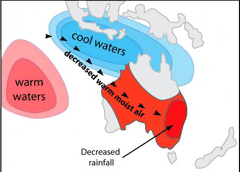
The Indian Ocean dipole’s positive phase: warm water leads to weaker, drier winds, and less rainfall on southern Australia. (Courtesy of the UNSW Climate Change Research Centre)
GELLERMAN: From the Jennifer and Ted Stanley Studios in Somerville, Massachusetts - this is Living on Earth. I’m Bruce Gellerman, in for Steve Curwood.
Australians call it the Big Dry. For 15 years southeastern Australia has been suffering from a severe drought leaving it bone dry and parched, perfect conditions for the deadly bushfires that recently tore through the region destroying forests and farms, devastating homes and lives.
Caroline Ummenhofer is a fellow at The University of New South Wale’s Climate Change Research Center. She says South East Australia has had droughts before but never like this.
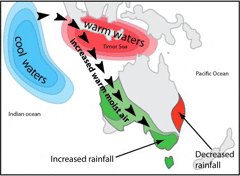
There has been no negative—or wet—phase of the Indian Ocean dipole for 17 years, leaving southeastern Australia parched. (Courtesy of the UNSW Climate Change Research Centre)
UMMENHOFER: It’s unprecedented in its intensity. And it has been unclear what has caused this big dry. Now Australia has had major iconic droughts over the last 120 years like the Federation Drought, the World War II Drought, but this latest drought, The Big Dry, is really something that we haven’t seen before because it’s so intense.
GELLERMAN: Well, what is causing this? If you’ve never seen something like this before, how do you account for it?
UMMENHOFER: What is surprising is that normally drought conditions over eastern Australia are associated with El Nino, La Nina cycles in the Pacific Ocean. These are temperature changes that affect the rainfall and circulation over the whole Pacific Ocean and the surrounding areas. However, what we could find is that, El Nino is not able to explain this latest drought, The Big Dry. Instead what we found is actually that the cause lies in Indian Ocean temperatures
GELLERMAN: So something is happening that’s different in the Indian Ocean. What is it?

The Indian Ocean dipole’s positive phase: warm water leads to weaker, drier winds, and less rainfall on southern Australia. (Courtesy of the UNSW Climate Change Research Centre)
UMMENHOFER: Yes. The Indian Ocean has a similar phenomenon to the El Nino, La Nina cycle. It’s called the Indian Ocean Dipole, and it’s a naturally occurring phenomenon and has been known for some time to influence Australian climate and Australian weather. The dipole oscillates between positive and negative phases and has neutral years in between as well, so the negative and the positive are the two extremes. And the normal wet conditions that you experience over south-east Australia are linked to the negative Indian Ocean dipole event which we haven’t seen over the last seventeen years.
GELLERMAN: And the negative effect would bring wet weather. And so you’ve had this prolonged dry weather.
UMMENHOFER: Exactly. During the negative phase we have wet conditions over the southeast of Australia. And the last India Ocean Dipole event of the negative phase occurred in 1992. That is unusual. We haven’t anywhere in the record over the last 120 years that we’ve investigated seen a similarly prolonged period without a single negative event, and therefore, this drought and sustained drought conditions in the southeast.
GELLERMAN: Well could it be that the Indian Ocean is getting warmer and that’s why you’re getting more positive, dry events in southeast Australia?
UMMENHOFER: The Indian Ocean is certainly been getting warmer. Most of the earth’s oceans have been getting warmer, but the Indian Ocean in particular. And there might be indications that this could lead to changes in the characteristics of Indian Ocean dipole events.
GELLERMAN: You know back in 2007 the United Nations Panel on Climate Change predicted that there was going to be an increase in intensity and frequency of droughts right there in southeast Australia.
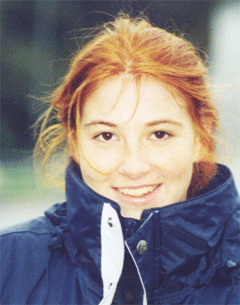
Caroline Ummenhofer, the lead scientist on the dipole and drought study. (Courtesy of the UNSW Climate Change Research Centre)
UMMENHOFER: Yes. This is consistent with predictions or projections what could be expected under global warming or climate change. But this is not work that I have done, like we have not, so far, investigated if there has been changes in the infrequency of the Indian Ocean Dipole. However other work by colleagues have suggested that we might be moving toward more positive events in the Indian Ocean Dipole and that is linked to a strengthening East Asian monsoon and to drier conditions over Australia, which wouldn’t be very good news for Australia.
GELLERMAN: So if I hear you correctly, you really can’t say whether climate change is responsible for this very unusual weather that you’re having in southeast Australia.
UMMENHOFER: That is correct. It’s not possible or very hard to attribute a single event to climate change. However, if you think about a warmer background state overall, then extreme events on this warmer background state will probably be more intense or more serious. And we found actually that the drought conditions have been exacerbated in the southeast due to recent higher temperatures, so it’s not just the lack of rain fall. But because of higher air temperatures, we also see more evaporation and, therefore, a worsening of the drought.
GELLERMAN: Caroline Ummenhofer is a fellow at The University of New South Wale’s Climate Change Research Center.
Related links:
- The UNSW Climate Change Research Centre
- For more on Caroline Ummenhofer’s work, click here
[MUSIC: Marc Ribot “Fuego” from Party Intelectuals (Pi Records 2008)]
Clinton Takes on China
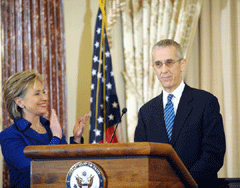
Secretary Clinton announces the appointment of Special Envoy for Climate Change Todd Stern. (Photo: Michael Gross, Courtesy of the State Department)
GELLERMAN: Secretary of State Hillary Clinton is on her way to China. It’s her first trip overseas as the top U.S diplomat and near the top of her agenda is climate change.
China and the United States are the world’s biggest producers of greenhouse gases and any hope of a global agreement to reduce emissions will require getting the industrial rivals to find common ground — it’s a task made a lot tougher by the current economic downturn.
But as Living on Earth’s Jeff Young reports, Clinton’s trip comes amid new optimism that a breakthrough agreement just might be possible.
YOUNG: For more than a decade China and the US have been frozen in place on global warming. Neither will agree to cut greenhouse gas pollution if it gives the other a competitive edge. The US says China will steal jobs; China says climate colonialism limits its right to lift people from poverty. Each used the other as an excuse for inaction in round after round of fruitless international talks.
With her trip to China, Secretary of State Hillary Clinton seems intent on breaking that stalemate.
CLINTON: We will also vigorously pursue negotiations that can lead to binding international climate agreements. No solution is feasible without all major emitting nations joining together and playing an important part.
YOUNG: Clinton made those comments when appointing her special envoy on climate change, Todd Stern, who will travel with her to China. Their talks are expected to include ways the nations can share technology to improve energy efficiency, capture CO2 emissions from power plants and, eventually, agree on ways each country can reduce emissions. And Chinese officials seem receptive.
XIE FENG: We are all living under the same azure sky, on the same planet. The earth is our common home. It is the only home we have.
YOUNG: No that’s not a Sierra Clubber speaking, it’s Xie Feng, a high ranking minister at China’s embassy in the US, waxing poetic about his country’s commitment to dealing with climate change. At an Asia Society event at the Capitol, Xie listed actions his country has taken to improve auto fuel efficiency, close some of its dirtiest power plants and keep forests intact. And he greeted the new Obama administration’s stance on climate warmly.
XIE FENG: We are pleased to note that President Obama also puts energy and climate change on the top of his to-do list. As long as the two sides work in the same direction, we are ready to work closely with the US side to play an active and responsible role in promoting international cooperation on energy and climate change.
[APPLAUSE]
YOUNG: However laudable the goals, there are serious questions about what progress China is really making and little ability to independently verify its efforts.
And for every report of a dirty power plant closing down, there are projections that energy hungry China will increase its CO2-spewing coal power.

Secretary Clinton announces the appointment of Special Envoy for Climate Change Todd Stern. (Photo: Michael Gross, Courtesy of the State Department)
Which is the real picture of China’s energy policy?
[MURMUR OF BUSY ROOM]
CLAUSSEN: I think it’s both, Hah!
YOUNG: That’s Eileen Claussen of the Pew Center on Global Climate Change.
CLAUSSEN: Will they continue to build coal plants? I think they will. Do they care about climate change? I think they do. I believe that the challenge is to find a way to burn coal so that it does not harm the climate.
YOUNG: So to a large degree the China question is the coal question?
CLAUSSEN: I think that is the most important question. And if we can’t deal with this technologically, nothing else we do, no matter how many agreements we sign, we won’t be able to address climate change.
YOUNG: The Pew center and Asia Society released a report they call a roadmap to US China cooperation on climate change. At the top of the list: sharing technology on coal, especially ways to capture and safely store CO2 emissions.
Of course there are nagging doubts about whether such technology, called carbon capture and storage, is worth the cost, or even possible on the large scale required. But if you’re looking for common ground in the China-US climate conundrum, coal is it. Coal generates about half the electricity in the US. And Duke University visiting fellow Jon Anda says it’s an even greater part of China’s fuel mix.
ANDA: It’s everything in China—China, climate, coal. If you look at projections going to 2030, you have one fuel, coal and three countries U.S., China and India – that is over half the CO2 emitted in the world. Three countries, one fuel. So you have to get at it and the U.S. and China engaging on coal I think is a really good way to start talking.
YOUNG: Global warming won’t be the only crisis on Clinton’s agenda - there’s also that matter of the global financial meltdown. That means heightened economic and trade tensions, less capital for clean tech investment, and further complications for any climate talks. But it could also mean a chance for a fresh look at how energy and the economy intersect. Orville Schell directs the center on US-China Relations at the Asia Society.
SCHELL: It’s precisely at moments like this, when everything breaks down, where the old systems melt away, that it is possible to reformat things and build new institutions and new ways of doing things. And I actually think we are entering such a period.
[CONVERSATION IN CHINESE]
YOUNG: I caught up with Chinese embassy minister Xie Feng briefly after his talk to the Asia Society. Xie says China has some 20 million rural workers now jobless. But he echoed Schell’s thought that dark times could be turned to a brighter outcome. In fact, Xie says, the Chinese word for crisis implies that very thing.
XIE FENG: The Chinese word for crisis is pronounced as “wei ji.” “Wei” stands for danger, and “ji” stands for opportunity. So, if you handle them properly then the danger can turn into opportunity. [Laughs] Hopefully this will be the case on the climate change and energy.
YOUNG: No one expects Secretary Clinton to return from her first trip with a climate agreement in hand. But observers from both sides of the Pacific have high hopes for important first steps in a new direction.
For Living on Earth I’m Jeff Young in Washington.
GELLERMAN: And this note: United Nations Secretary-General Ban Ki Moon is expected to invite President Obama and other world leaders to a climate change "mini-summit" in New York at the end of March. Reportedly, the purpose of the meeting would be to ensure that the world financial crisis does not disrupt the process towards a new global climate change agreement.
The Secretary General has declared 2009 the year of climate change.
[MUSIC: Zuco 103 “Outro Lado” from Brazil 2 Mil (Six Degrees Records 2005)]
GELLERMAN: Just ahead – Farmed salmon versus wild salmon. There’s more at stake than just fish. Keep listening to Living on Earth!
Related links:
- Roadmap for U.S.-China cooperation on climate change from Asia Society and Pew Center
- U.S. State Dept. office on global climate change
- Linguistic quibbling about the translation of the Chinese term for "crisis"
[CUTAWAY MUSIC: Amina Figarova: “Ernie’s Song” from Above The Clouds (Munich Records 2008)]
After the Floods
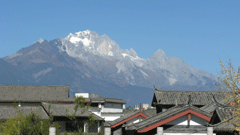
Mount Yulong overlooking Lijiang town. (Courtesy of Elise Potaka)
GELLERMAN: It’s Living on Earth, I’m Bruce Gellerman.
In China, decisions about economic development and infrastructure projects are generally handed down from above. Affected communities rarely have any meaningful say in the process, and are left to deal with adverse social and environmental impacts as best they can. But, as reporter Elise Potaka discovered, in southwest Yunnan province, at least one community is forging a new path.
[MUSIC, SOUND OF CROWDS]
POTAKA: On the cobble-stoned streets of Lijiang, an old man plays the Chinese erhu to passing tourists.
The town’s traditional architecture, as well as the view of the snow-capped Mount Yulong, make it one of China’s most popular tourist destinations.
Last year, five million visitors brought in around seven billion U.S. dollars.

Mount Yulong overlooking Lijiang town. (Courtesy of Elise Potaka)
[SOUND OF RUNNING WATER]
POTAKA: A major attraction are the streams, canals and wells which criss-cross the town’s narrow alleyways.
[MAN SPEAKING IN CHINESE]
POTAKA: The water in Lijiang is very sweet, this tourist says with a smile, as he drinks long mouthfuls from one of the wells.
[SOUNDS OF TOWN]
POTAKA: In the past, Lijiang's water came from the snow melt of Mount Yulong. But the snow has been disappearing for more than a decade now, probably due to a changing climate.
With less run-off, the city's water levels also began to drop.
Concerned that the diminished water in the canals would draw fewer tourists, local officials went in search of another water source.
[SOUNDS OF BIRDS, LAKE]
POTAKA: It’s early morning, and at the edge of Lashi Lake - about half an hour out of Lijiang - birds preen in the warming sun.
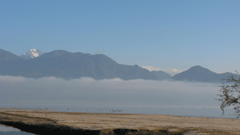
Lashi Lake. (Courtesy of Elise Potaka)
It was here that the government, in the late 90's, built a dam, diverting forty percent of the lake's water to the streams and canals of Lijiang.
With a total area of over 2000 acres, and more than 3000 people living close by, the impacts have been huge.
[PEOPLE SPEAKING IN CHINESE]
POTAKA: Niang Yao Jun lives at Xihu village, just uphill from the shoreline. He says they used to live off fishing and growing crops near the lake.
But the dam changed all this.
NIANG: [translated from Chinese] Our fields were flooded, so we asked the authorities to solve the problem and give us farmers other land. They helped us plant potatoes but when the rainy season came there were landslides, erosion and other problems like that.
POTAKA: Looking for a longer term solution they engaged the support of researchers from a small local environmental group called Green Watershed.
They wanted to find a more environmentally sustainable way to make a living.
The researchers suggested that agro-forestry could be one part of the solution.
Along with their crops and livestock, villagers could grow trees to hold the soil.
They could sell some of the timber.
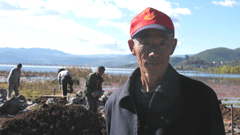
Niang Yao Jun during the construction of the wharf. (Courtesy of Elise Potaka)
NIANG: [translated from Chinese] We started with just ten thousand households in 1998, on an area of 20 acres. Two years later we were already seeing profits. It's reduced the problem of erosion, and increased our income.
POTAKA: Now villagers can make an annual profit of around 3000 US dollars per acre from the timber.
This has almost replaced the income that villagers lost when their fields were flooded.
[VILLAGE SOUNDS, FOOTSTEPS, A WOMAN SPEAKING IN CHINESE]
POTAKA: Walking along one of Xihu Village’s dirt roads, He Cui Ma, picks up rubbish as she goes. She says they don’t want plastic pollution to fall into the lake.
She points to another initiative which villagers have started – they now make money from fruit and vegetables grown using less chemicals.
HE: [translated from Chinese] We use few pesticide and we’ve founded a committee to look into this. The most harmful pesticides are now banned and we use much less chemical fertilizer than before. Instead we use marsh gas fertilizer.
[VILLAGE SOUNDS]
POTAKA: While the group Green Watershed has been integral in setting up the programs, it’s a partnership which emphasizes the importance of local knowledge.
Hu Chengshen is a program officer with the group.
HU: [translated from Chinese] Local people understand this area more than we do. In our opinion they're the real experts. For example, they know where and when you can harvest wild food to take back with you, what you can and can't eat. They are our teachers.
[COFFEE CUPS RATTLING]
POTAKA: In Beijing for a conference, founder of Green Watershed, and winner of the Goldman prize for the environment, Professor Yu Xiaogang, takes time out in a café.
He believes the project could be used as a model for other communities affected by developments like dams.
He says the key is to give the community a stronger voice.
YU: We first found that local people were very angry but they don't know how to raise their idea, their opinion to the government. Local people cannot participate in the decision-making because many decisions are made top-down, and made by the outside people. But local people are marginalized, neglected from decision-making.
POTAKA: To change this they set up local committees to make decisions about fishing and water use.
[VOICE TALKING AT MEETING]
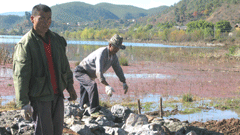
Building the wharf. (Courtesy of Elise Potaka)
POTAKA: At gatherings like this one, villagers can now exchange views and present their ideas to other stakeholders including local government representatives.
And Professor Yu says those powers are listening.
Most recently, villagers and NGOs proposed that some of Lijiang's tourist profits be shared with upstream communities.
YU: They got a lot of money from tourism because of the water, so they should also feedback some profit to this lake area. And now the local government gradually appreciates this kind of concept. They've decided to allocate some money from the tourist business, pay to the upstream, to the lake area. This payment will further encourage the local people to have more sustainable projects to manage this resource.
POTAKA: Starting next year, some of Lijiang’s billion-dollar tourist profits will be sent to Lashi Lake to be used on nature conservation and poverty alleviation.
The aim is to channel around $290,000 U.S. to villages each year.
[SOUND OF HAMMERING]
POTAKA: Back at the lake, villages are working together to rebuild the fishing industry, as well as initiate small-scale tourism.
Here at the lake's edge they're building a small wharf. Local Liang Zhong Kun explains.
LIANG: [translated from Chinese] The purpose of the wharf is to manage the boats and fishing industry in the Lashi Lake area. We hope to extend the wharf into a leisure venue where people can watch birds, row boats and relax.
[SINGING]
POTAKA: As the sun sets, locals gather together to eat, as well as to sing and dance.
They know the challenges are far from over.
But at least now, they have a new set of survival skills and, more importantly, a seat at the decision-making table.
In Yunnan, I’m Elise Potaka for Living On Earth.
[MUSIC: Music provided by the reporter and recorded on location]
Fish Farming and First Nations
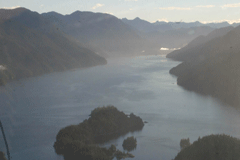
The Broughton Archipelago lies roughly 250 miles north of Vancouver. (Photo: Alexandra Morton)
GELLERMAN: More than 40 percent of the world’s seafood is farm-raised and one of the largest centers for farming salmon is British Columbia, Canada. In the Broughton Archipelago alone, along Vancouver Island there are 29 fish farms.
But a lawsuit, just filed by First Nation tribes, claims that farmed salmon raised in open nets at sea are threatening wild salmon, and aquaculture is undermining a billion dollar economic food chain and a way of life. Chief Bob Chamberlin speaks on behalf of the First Nations in the lawsuit.
CHAMBERLIN: Well when you come into the territory of our people, it was once incredibly bountiful with every type of marine species you could imagine. And right now there’s a serious and sharp decline in pink salmon stocks, chum stocks, the various species of clam, herring, bouligan. There’s not one species that’s doing well. The only thing new in our territory is the fish farms.
GELLERMAN: So how are farm-raised fish hurting the wild fish?
CHAMBERLIN: Well, the farm-raised fish or the open net caged farm fish systems - are just ideal to capture the sea lice from the wild salmon that come back to spawn and it allows for a perfect environment for them to proliferate throughout the year.
GELLERMAN: Sea lice?
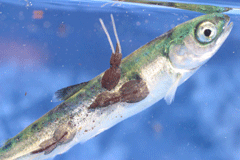
Young pink salmon smolt infected with sea lice. The open net pens are fertile habitat for sea lice, as well as farmed salmon. (Photo: Alexandra Morton)
CHAMBERLIN: Sea lice, that’s correct.
GELLERMAN: What do the sea lice do to your fish?
CHAMBERLIN: Well, the small salmon smolts that leave the river do not have their scales developed, so they’re not able to fend off a parasite such as this. So it takes very little in terms of numbers of sea lice to kill the smolts when they leave the river.
GELLERMAN: So you’re saying the fish farms and the sea lice are what’s causing the collapse of these wild fisheries.

Broughton inlet. (Photo: Alexandra Morton)
CHAMBERLIN: Well I think it’s more than just the sea lice, and that’s the thing that I want people to understand is when we talk about the impacts on wild salmon, that is one impact from this industry. Though it’s a very significant impact, there are other impacts in the region which are not being accounted for or researched and documented.
GELLERMAN: Well Chief Bob Chamberlain, hang on, because I want to bring into the conversation now Alexandra Morton. Ms. Morton,
MORTON: Hi
GELLERMAN: You’re a marine biologist who’s lived up there for what – decades I guess, right?
MORTON: Yes, since 1984.
GELLERMAN: And you’ve studied the effects of farm raised salmon on the wild fish.
MORTON: Yes, originally I was studying the killer whales in the area, but – and I thought the fish farms were a good idea, but as they moved in and got bigger, the impacts just grew. And that was the problem, because initially the farms only had a 125,000 fish per farm. And then they grew to the point where – at points we had 1.3 million fish per farm. Now what happens with the farm is when a fish becomes sick, it spreads to the other fish, and it brews the disease, whatever it is, to the point where the pathogens are pouring out at a level that the wild fish just can’t bear. It’s the difference between standing a football field away from a guy with the flu to being stuck in an elevator with six guys with the flu, you know. Under one condition you won’t get it and the other, you probably will. And that’s where the balance gets upset.
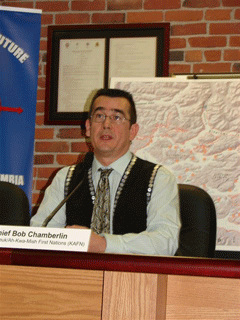
Chief Bob Chamberlin.
GELLERMAN: You know I just noticed before I gave you a call that the premier of B.C., Gordon Campbell, came out with a new report that was four years in the making. It’s from the B.C. Pacific Salmon Forum and they say that wild and farm fish can coexist.
CHAMBERLIN: There would have to be some pretty stringent criteria set around the operation of these farms for us to agree to that.
GELLERMAN: What would you like to see?
CHAMBERLIN: I would like to see the fish farms not located on migratory routes of wild salmon smolt.
GELLERMAN: That way they wouldn’t pick up these lice.
CHAMBERLIN: That’s correct. I think we all can agree that nature is perfect in everyway, so when wild salmon would come to the river to spawn, they would indeed have sea lice on them. But when they would die after they had reproduced in the rivers, the sea lice would eventually die in the region as well.
GELLERMAN: Ms. Morton, they use open nets right now. And they put them into these waterways. Why don’t they just enclose them?
MORTON: Oh. Because they’re the only farmers in the world that don’t shovel their manure. And they’re putting in tons of food. And one of my studies right now is on the mountains of sediment that are sitting on the sea floor in Chamberlin’s territory. They don’t want to deal with that stuff. No one does. So right now they are getting a free flush.
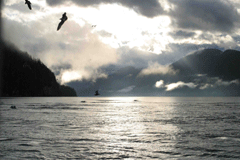
A deep sea bluff in British Columbia. (Photo: Alexandra Morton)
GELLERMAN: Well what are the conditions of the wild salmon right now? How many more runs of wild salmon can make it around these fish farms in the archipelago and out to the ocean with the present conditions?
MORTON: None of them. They’re all doing very poorly. The littlest salmon we have, the pink and the chum, they are dying outright. And then the larger ones, the spring salmon, Chinook or king as they’re called, and the Coho, they eat these infected little pink and chum fry and then the lice get on them. And the wild salmon are like a power cord to British Columbia. They go out to the ocean and they pick up all the energy out there from the sun hitting the water, creating plankton blooms and all that goes on there. And they package it into a delicious package and then they come back to us on a schedule. This is incredibly valuable. This is why the Broughton Archipelago supported over 10,000 First Nations people. They are funding a huge wilderness tourism industry. They are feeding the trees that are pulling the carbon out of the atmosphere. They’re one of those animals designed to feed the masses and make systems work. And so if you cut them, the whole province is gonna dim.
GELLERMAN: Chief Chamberlin, sounds like really what you’re saying is that, no, the fish farms can’t co-exist with the wild fish.
CHAMBERLIN: What I’m saying is it’s the obligation and the right of every First Nation to have meaningful input into the activities that go on within their traditional territory. And there are First Nations on this coast that are very supportive of aquaculture industry. But I want them to be able to have the opportunity to make that decision for an activity in their territory. But by saying that, I also want our First Nation’s view on this and the decision to not have it in our territory also respected.
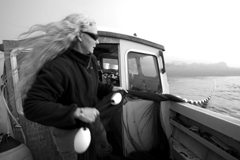
Alexandra Morton hauls in a net. (Photo: Nik West)
GELLERMAN: Well it seems the implications of what happens on the Broughton Archipelago could be vast, because farm fishing is enormous, and it’s going to only get bigger. And this could have an effect upon fish farms worldwide.
MORTON: Yeah, well there’s all kinds of fish farming. The problem with salmon farming from just a completely objective point of view is they’re farming carnivores. So there are fishing stocks and then they’re feeding those fish to the farm salmon. And then they’re taking out less fish. So it’d be like farming wolves by feeding them chickens. But farming a fish that eats vegetable matter and then you take the waste of the fish to grow your vegetable crops, well now you’re into a closed system that can prosper. Farming salmon – I don’t think it’s gonna last. They’re running out of wild fish, they have huge disease problems worldwide. Their shareholders are taking a beating. And as soon as the U.S. decides they can’t afford the product, they’re out of here, and we’re left with their mountains of waste on the sea floor.
GELLERMAN: Chief Chamberlin, what happens to the First Nations on the Archipelago if the salmon don’t come back, the wild salmon are gone?
CHAMBERLIN: That is – would be such a catastrophe. You have to appreciate that wild salmon are an integral piece to our way of life and our culture. I’ll use the most recent example. Last weekend I was at a naming feast for a small child, and when I attended that feast I knew exactly what I would be eating and it would be all the seafood that’s from our territories. Within our culture we have various dances and, you know, there’s a salmon dance. It’s something that our twins of our families dance. You know how special twins are to any given family of any culture, and those are the ones that do the salmon dance for our territories or for our people.
GELLERMAN: Well Chief Chamberlin and Ms. Morton, thank you very much. Really appreciate it.
CHAMBERLIN: Thank you – appreciate your interest.
MORTON: Thank you so much.
GELLERMAN: Biologist Alexandra Morton and Chief Bob Chamberlin spoke to us from the Broughton Archipelago.
And we have this response from one of the largest fish farming companies in the region, Marine Harvest, quote: “the industry is committed to stringent standards and sustainability on the British Columbia coast."
Related links:
- Alexandra Morton's website
- For more on Alexandra Morton's efforts, click here
- Watch a video address to Marine Harvest, the largest aquaculture company in the Broughton Archipelago
ECOtime
[ECOTIME THEME]
GELLERMEN: When it comes to nature - the eyes have it, as the folks at the ECOcalendar project remind us in this audio snapshot they call ECOtime.
HARDMAN: Eye Shine. We humans are diurnal, meaning we're daylight animals. We don't do well when we're in the dark. But others see just fine. Plenty of animals, including many fellow mammals, lions and tigers, and cats and dogs, have eyes that are able to reinforce small amounts of light.
Light goes in their eyes, and it hits the receptors. Then it bounces off a mirror-like membrane, called the tapetum lucidum, to hit the receptors again, so they see the light twice.
You've probably seen the effects of this reflector, at night, when light hits their eyes, it shoots back brightly. It's an eerie sight, partially because many of the animals that have the tapetum lucidum, are hunters.
[HOWLING]
GELLERMAN: That's Chris Hardman with ECOtime, part of the ECOcalendar project. For more, check our website loe.org.
[MUSIC: Thievery Corporation “Resolution” from Babylon Rewound (Eighteenth Street, 2004)]
GELLERMAN: You can hear our program any time on our website, or get a download for your MP3 player. The address is loe.org. That’s loe.org. There you’ll also find pictures and more information about our stories, and we’d like to hear from you. You can reach us at comments@loe.org. Once again, comments@loe.org. Our postal address is 20 Holland St, Somerville, MA 02144. And you can call our listener line at 800-218-9988. That’s 800-218-9988.
Just ahead: Green games to cool the planet. Stay tuned to Living on Earth.
REEVES: Let’s have some fun. Let’s go on a quest, see who can do this better than others: all the different features of games that are important. If we can get that going at the same time as the community value, we might have something special.
GELLERMAN: Stay tuned to Living On Earth.
ANNOUNCER: Support for the Environmental Health Desk at Living on Earth comes from the Cedar Tree Foundation. Support also comes from the Richard and Rhoda Goldman fund for coverage of population and the environment. And from Gilman Ordway for coverage of conservation and environmental change. This is Living on Earth on PRI, Public Radio International.
[CUTAWAY MUSIC: BeatleJazz: I’ll Follow The Sun from Another Bite Of The Apple (Zebra Records)]
The Language of Landscape
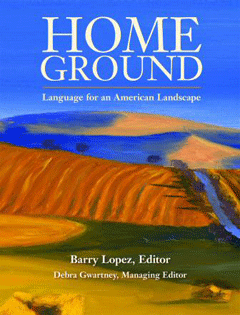
homeground
GELLERMAN: It's Living on Earth, I'm Bruce Gellerman.
[MUSIC: Daniel Lanois “O Marie” from Acadie (daniellanois.com 2005)]
Here in the northern hemisphere, the days are getting longer – a sure sign that winter’s losing its grip. And while the groundhog may yet be right, and the cold may linger, look closely and you’ll see the buds starting to swell, and the landscape - our home ground – coming back to life.
But sometimes there’s too much of a green thing growing. You’ll find a definition of one wild and wide spreading plant in the book, “Home Ground.” It’s a compilation of American landscape terms we’ve been featuring occasionally on Living on Earth.
Barry Lopez and Debra Gwartney are the book’s editors. Today poet Pattiann Rogers reads her definition of Kudzu.

homeground
ROGERS: Kudzu. In large portions of the southeastern United States, the Kudzu vine, rapacious and fast-growing, has overtaken the countryside, covering Dixie like the dew. Growing sixty feet or more in a season, this woody, hairy vine, originally a native of Japan and China can completely engulf large trees, telephone poles, abandoned cars, small sheds, little-used country roads. Kudzu is believe to cover more than seven million acres of rural areas in the south, and has been found as far north as New York, as far west as Texas, and commonly in the mid West, including Ohio, Indiana, Illinois, Missouri and Kansas.
Luckily, winter frost kills the vine, although it’s roots survive.
People residing in Kudzu country have adopted the vine good naturedly as an emblem of their home place, and enjoy telling tall tails about it. For example, there’s the one about an escaped prisoner who fled into a Kudzu patch and is still unaccounted for.
The Kudzu Kings, a musical outfit, advertise themselves as the purveyors of southern-roots-rock-drunken-country-jungle-boogie-Americana from Oxford, Mississippi.
[MUSIC: Kudzu Kings: “Truly” from Kudzu Kings (CD Baby/Kudzu kings 1997)]
GELLERMAN: Poet Pattiann Rogers lives in Colorado. Her definition of Kudzu appears in the book: “Home Ground: Language for an American Landscape” edited by Barry Lopez and Debra Gwartney. Yeeha!
Related link:
The Home Ground Project
Painting the Town White

In Santorini, Greece houses are painted white to keep them cooler. (Photo: Jaap Engel)
GELLERMAN: When it comes to taking on the challenge of climate change, California leads the way – with the nation’s most comprehensive plan to control greenhouse gas emissions.
Now Arthur Rosenfeld, the state’s energy commissioner has come up with another bright idea to cool the planet. He wants to paint the town white – or at least, the roofs and roads. Arthur Rosenfeld joins me from his office in Sacramento.
Hello Commissioner!
ROSENFELD: Hello, Bruce.
GELLERMAN: So, white roofs and roads can help cool the planet, how?
ROSENFELD: Well, everybody who’s ever walked on a roof knows if it’s white it will only heat up maybe ten degrees above ambient temperature. If it’s some nice architectural green or terracotta tiles or whatever, it can heat up to eighty degrees above room temperature. So a white roof reflects solar radiation back into space where it’s transparent, where it belongs, and a dark roof traps heat and contributes to the greenhouse effect.
GELLERMAN: We should say this is not a new idea. The ancient Greeks knew about building in light colors long, long ago.
ROSENFELD: The Greeks have known to white wash their roofs and their whole buildings for 2,000 years, and the Pharaohs had white roofs 5,000 years ago.

In Santorini, Greece houses are painted white to keep them cooler. (Photo: Jaap Engel)
GELLERMAN: Well, calculate the effects. I just put a new roof on my house actually. I live just outside of Boston. And how much money would I save if I put up a white roof. I gotta tell, you I put up a dark roof.
ROSENFELD: Instead of giving it to you in dollars, because I don’t know your air conditioning load and your habits, I can say that it will reduce your air conditioning by 10 to 20 percent, or your air conditioning load on the summer by 10 to 20 percent if the roof is white instead of whatever you put up. White roofs are good because they save air conditioning and they’re common sense. But in addition the white roof, because it doesn’t trap energy, reflects it back into space, cools the world directly. And for 1,000 square feet which is like half the area of your house, a white roof as opposed to a dark roof cools the world enough to offset the heating effects of ten tons of carbon dioxide. That’s like two and a half years of emissions from your family car or like one year’s emissions from your house near Boston. And that’s why we’re so excited right now.
GELLERMAN: What about in winter? I mean doesn’t a dark roof absorb heat as you said and that would lower the winter energy costs?
ROSENFELD: Right. That is a problem, which we call the winter penalty. In Boston it runs nearly 15 percent, that is if you save a dollar on air conditioning in the summer, you pay back fifteen cents worth of natural gas for the heating in the winter. But if you’re in Birmingham, Alabama the winter penalty is only about five percent. And the reason for that is that in the summer, the sun is high and sees mainly the roof. In the winter, the sun is low and sees mainly the south wall. So a really architecturally-colored proper building will have a light colored roof for the summer time and a dark colored south wall to absorb heat in the winter.
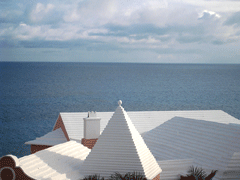
These white roofs in Bermuda reflect solar heat back to the atmosphere instead of absorbing it as dark roofs would. (Photo: Lornette Simons)
GELLERMAN: I know that California has a requirement for flat roofs. It’s had it since 2005. They have to be white. And now you’re going even further.
ROSENFELD: Yes, we’re going further in two directions. What we’ll require in California on a new building is that if it’s flat and there’s no architectural issues, then it’s gotta be white, and a re-roofing job has got to be white. We have invented cool colors, which is pigments, which are naturally occurring but selected to be any color you want in the visible, but highly reflective – that is kind of white – in the near infrared. And so in California, starting next August, if it’s a sloped roof in our hottest climate zones, it must be one of these cool-colored pigments. Another interesting idea is that California State Fleet will start to purchase only cars which are white or metallic gold or metallic silver – those are, those run about 18 degrees cooler when parked – the skin of the car when parked on the parking lot. You can down size the air conditioner. So, that’s the way we’re going in California.
GELLERMAN: I understand you’re taking your idea for white roofs on the road. You’re headed for China and India.
ROSENFELD: Right. The Chinese have mandatory building standards and I want to convince them to make white roofs a high priority. If you landed an airplane in Shanghai or Beijing you find lots of flat roofs which are red or blue, but not white as they should be. The Indians have voluntary standards, and I want to try to convince them to make their first mandatory standard which costs nothing and is easy to enforce to be a white roof. If white roofs took over the world or the urban world over a twenty year program, we would save twenty five billion tons of CO2, which is the same as turning off the whole world’s emissions of CO2 for one year. It’s a wonderful way to delay global warming and at the same time cool your communities and save air conditioning energy and save a little bit of extra CO2 from the electricity at the power plant.
GELLERMAN: Well Commissioner Rosenfeld, thank you very much.
ROSENFELD: It was a pleasure. Hope we talk again.
GELLERMAN: White roof advocate Arthur Rosenfeld is the Energy Commissioner for the Golden State of California.
Related links:
- Click here for a two-page, non-technical summary
- Click here for a technical summary
[MUSIC: It’s A Beautiful Day “White Bird” from It’s A Beautiful Day (It’s About Music 2005)]
Green Gaming

World of Warcraft (Photo: Blizzard Entertainment)
GELLERMAN: President Obama’s stimulus package calls for 40 million smart electric meters to be installed in American homes. Oh, sure they’re smart - but can they play World of Warcraft?!?
[SOUND OF WORLD OF WARCRAFT: Four years have passed since the mortal races banded together and stood united against the might of the Burning Legion. Though Azeroth was saved, the tenuous pact between the Horde and the Alliance has all but evaporated…]
GELLERMAN: World of Warcraft, known as WOW to aficionados, holds the Guinness Book Record as the most popular Massively Multiplayer Online Role-Playing Game. WOW!
Massive yes. More than 11 million people around the world play World of Warcraft, making mayhem with the Horde and the Alliance, earning points, defeating monsters.
[DRUM AND GAME SOUNDS]
GELLERMAN: Since both World Of Warcraft and smart electric meters are on-line - Professor Byron Reeves of Stanford University believes the raw power of WOW in the virtual world could be harnessed to save energy in the real world.
REEVES: It’s a chance to play with a team. It’s a chance to meet people, a chance to represent yourself in media rather than actually sitting on the other side of the screen only absorbing media. It’s a chance to get feedback, to go on quests, to be engaged with groups, to do a lot of the different things that people do in real life in a way that is a whole lot of fun.
GELLERMAN: So how does it work? Let’s say I’m a subscriber to World of Warcraft, and I’ve got my account. How does it tie into my meter?
REEVES: So, imagine that you’re in your home, you’re signed into this game, you have played this game before. You’re on a team. You’re in an entertainment context. You have a representation of yourself in this game just like you do in all the entertainment games. And you make a decision in a game to turn off the lights in an unused bedroom. As soon as you do that, the smart meter recognizes that, sends the information through the network to your computer, and your house turns a shade of green that it wasn’t before. And, if I’m using less electricity, my team might do well, I get goal pieces and points, whatever the game designers think is fun. In other words, you get feedback in an entertainment game about what you’re doing in the real world.
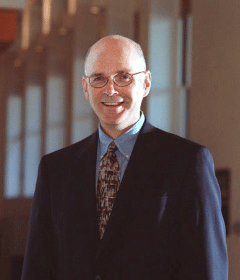
Stanford university professor Byron Reeves
GELLERMAN: So people will do something in a virtual world for points that they wouldn’t do in the real world for money? I mean, I could save money by simply turning off my lights.
REEVES: That’s a good question. So the whole goal here is to align entertainment and fun with utility and community value. So, of course, you could change your energy usage because you had read all the science about climate change and you knew something about energy usage in the house and you were interested in saving six cents here, a dollar there, two dollars there on your energy bill. But we don’t think that that will be enough motivation at scale for lots of people to get into this. So if you can align that goal with “let’s have some fun, let’s go on a quest, let’s have a team activity, let’s see who can do this better than others, let’s help each other” – all the different features of games that are important. And if we can get that going at the same time as the community value, we might have something special.
GELLERMAN: Well, Professor, let’s talk to a gamer. We have on the line Colin Ahearn, who happens to be the brother of our producer, Ashley Ahearn. Hi Colin.
AHEARN: Hi
GELLERMAN: So, you’re a game player. How much of your life do you dedicate to this game?
AHEARN: In my life, when I played heavily, it could be as much as eight hours a day. But recently I’ve been cutting back due to other commitments, such as college and everything that that entails, socializing, school work and writing papers and things.
GELLERMAN: Yeah, life.
AHEARN: Yeah, exactly, the real world.
[LAUGHING]
GELLERMAN: Well what about, you know, this idea of Professor Reeves’?

World of Warcraft (Photo: Blizzard Entertainment)
AHEARN: I think it’s an excellent idea. But one of the main things I notice is World of War Craft players are really hobbyists above all else. And that is – you create an avatar that represents you in a very real way, but in a very virtual environment. And that’s important to players because everything they do has some effect, either through an award, a reward or in some way bettering that character. And I think something that’s going to be very important to stress with the game for it to really take off is the rewards that can be achieved in game for achievements that they themselves do outside of the game, like turning off a light or doing less dishes or doing less laundry.
GELLERMAN: But, you know, Colin, I have a picture of you sitting there with all the lights off so you can save energy so you can make points so you can play your game, sitting there playing the game in the dark.
AHEARN: Yeah. That would be an extreme way to go about it. Absolutely.
REEVES: I think Colin actually hit on one of the features from our laboratory work that’s the most important. The notion of feedback. We know that feedback really works well when it’s tightly coupled with the behavior that’s generating the feedback. So, this could be a huge feature of the game. And it’s also something that the gamer generation, those people like Colin, that spend a lot of time in this game, have a reason to expect in non-entertainment contexts. So, a lot of these younger folks are looking for direction and feedback moment by moment.

Colin Ahearn green gaming in the real world(Photo: Colin Ahearn)
GELLERMAN: So Colin, how would the game be constructed so that you’d want to play it and save energy?
AHEARN: I think the most important aspect that – the addicting part to me that would make it something I would want to do - is a leader board is a really good idea. I like the idea that with the top players in the nation who use the least energy being able to compare yourself to them is key. It just generates that competition that brings people to a game. Also, it’s the quick, immediate reward.
GELLERMAN: You know, Professor, it sounds very powerful. I mean you’ve got 11 million players of this game on the planet. But the idea of social control by way of the net sounds a little creepy.
REEVES: Well, that may be in part a generational issue. I’m not sure it’s creepy to imagine yourself voluntarily entering a game space, you know, with friends, maybe some real life friends that you’ve brought in, maybe a dorm floor, maybe a neighborhood plays together, so it’s not only new people that you meet. I think it’s really - people are very comfortable with this. This is the facebook, myspace generation. We’re establishing, initiating social contact. The threshold for that is much lower. I think people would be very comfortable with it. If, as Colin said, it can be engaging and done with a great narrative and great characters and all the things that make movies and games and entertainment special.
GELLERMAN: Bryon Reeves is a professor at the department of communications at Stanford University in California.
GELLERMAN: And Colin Ahearn was an avid World of Warcraft player. These days he’s a junior at Oberlin College in Ohio. Colin, thanks.
AHEARN: Thanks for having me.
Related links:
- Media X
- To see a demo video of professor Reeves' gaming idea click here
[DRUMS AND GAME SOUNDS: World Of Warcraft Trailer (Blizzard Entertainment 2008)]
GELLERMAN: On the next Living On Earth.
Eighty percent of the world’s production of lead ends up in car batteries – leaving a trail of death and neurological damage.
PERRY GOTTESFELD: There are 120 million people who are overexposed to lead around the world – that’s three times the number infected with HIV/AIDS - and this problem seems to be growing throughout the developing world.
The toxic toll of lead batteries - next time on Living on Earth.
[SOUNDS OF MOUNTAIN RAINFOREST IN MADAGASCAR]
GELLERMAN: We leave you this week in one of the last remaining regions of mountain rainforest in eastern Madagascar.
[SOUNDS OF MOUNTAIN RAIN FOREST IN MADAGASCAR]
GELLERMAN: Ranomafana is known for its unique diversity and high number of endemic species. Doug Quin trekked through challenging terrain and recorded the wildlife for a wildsanctuary.com CD called “Madagascar: The Fragile Land.”
[SOUNDS OF MOUNTAIN RAIN FOREST IN MADAGASCAR]
Living on Earth is produced by the World Media Foundation. Our crew includes Ashley Ahearn, Bobby Bascomb, Eileen Bolinsky, Ingrid Lobet, Helen Palmer, Mitra Taj and Jeff Young, with help from Sarah Calkins and Marilyn Govoni. Our interns are Lindsay Breslau, Liz Gross and Christine Parrish. Special thanks this week to Jeff Silverman and Tom Taylor. Jeff Turton is our technical director. Alison Lirish Dean composed our themes. You can find us anytime at loe.org. Steve Curwood is our executive producer.
I’m Bruce Gellerman. You’ll hear from us again next week - Thanks for listening.
ANNOUNCER: Funding for Living on Earth comes from the National Science Foundation, supporting coverage of emerging science, and Stonyfield Farm: organic yogurt and smoothies. Stonyfield pays its farmers not to use artificial growth hormones on their cows. Details at stonyfield.com.
Support also comes from you our listeners, the Ford Foundation, the Town Creek Foundation, and the Oak Foundation, supporting coverage of climate change and marine issues; The Bill and Melinda Gates Foundation, dedicated to the idea that all people deserve the chance to live a healthy productive life. Information at gates foundation.org; and Pax World Mutual Funds: socially and environmentally sustainable investing. Pax World: for tomorrow. On the web at paxworld.com.
ANNOUNCER: PRI, Public Radio International.
Living on Earth wants to hear from you!
Living on Earth
62 Calef Highway, Suite 212
Lee, NH 03861
Telephone: 617-287-4121
E-mail: comments@loe.org
Newsletter [Click here]
Donate to Living on Earth!
Living on Earth is an independent media program and relies entirely on contributions from listeners and institutions supporting public service. Please donate now to preserve an independent environmental voice.
NewsletterLiving on Earth offers a weekly delivery of the show's rundown to your mailbox. Sign up for our newsletter today!
 Sailors For The Sea: Be the change you want to sea.
Sailors For The Sea: Be the change you want to sea.
 The Grantham Foundation for the Protection of the Environment: Committed to protecting and improving the health of the global environment.
The Grantham Foundation for the Protection of the Environment: Committed to protecting and improving the health of the global environment.
 Contribute to Living on Earth and receive, as our gift to you, an archival print of one of Mark Seth Lender's extraordinary wildlife photographs. Follow the link to see Mark's current collection of photographs.
Contribute to Living on Earth and receive, as our gift to you, an archival print of one of Mark Seth Lender's extraordinary wildlife photographs. Follow the link to see Mark's current collection of photographs.
 Buy a signed copy of Mark Seth Lender's book Smeagull the Seagull & support Living on Earth
Buy a signed copy of Mark Seth Lender's book Smeagull the Seagull & support Living on Earth

